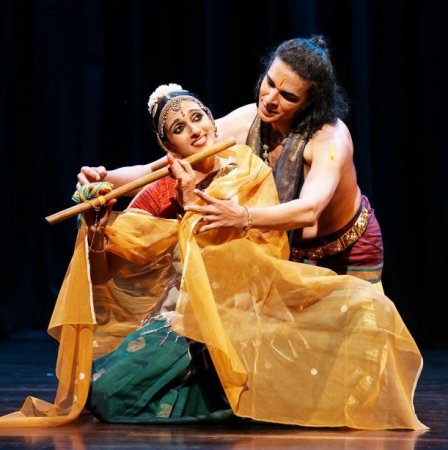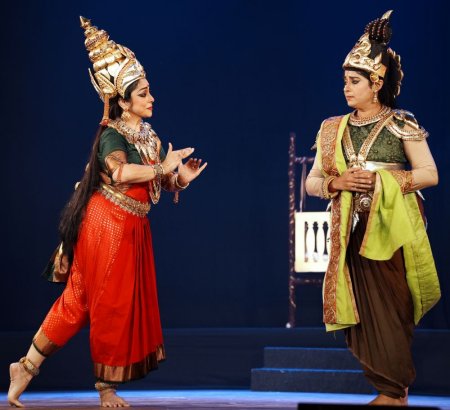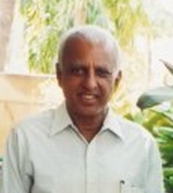
|   |

|   |
Enchanting and innovative thematic performances - Satish Suri e-mail: satishism@yahoo.co.in January 23, 2024 MAGIC BOW: AN INSIGHT INTO THE MIND OF THE VIOLIN MAESTRO LALGUDI JAYARAMAN 'Magic Bow' is a unique theatrical production that celebrates the musical genius of Lalgudi Jayaraman, a legendary Carnatic violinist and composer. The show is conceived, written, and directed by Dr Gowri Ramnarayan, a distinguished writer, critic, and theatre director, who explores the visual influences behind Lalgudi Jayaraman's varnams for dance. Through a blend of dance and narration, 'Magic Bow' showcased the diversity and innovation embeded in Lalgudi Jayaraman's compositions on January 10 at Bangalore International Centre. A Jatiswaram in Rasikapriya raga begins with a light-hearted lilt, portraying a playful boat ride of two lovers. The dissonant note in the composition sends out a warning. Their joy is interrupted by a storm that shatters their boat and leaves them on an island. They are grateful for surviving the ordeal. As dawn breaks, they see a boat nearby and manage to return home. The choreography by Sheejith Krishna and the performance by Sheejith and Anjana Anand turns this Jatiswaram into a charming visual story, engaging the audience with its stagecraft.  Magic Bow Photo: Prof.K.S.Krishnamurthy The varnam "Innun en manam" in raga Charukesi unfolds the tale of a love-lorn Nayika expressing her grievances to her lord, questioning his pretence and concealment. The narrator, in conversation and interaction with Lalgudi, reveals that the composer based this composition on the idea that as humans, we often find ourselves lost in illusions. It highlights how heightened consciousness can eventually reveal reality, making us feel merged with the divine. The piece conveys the profound notion that the divine is ever present, and it is we who constantly search for it. Occasionally, in fleeting moments, we manage to connect, akin to electricity always being present, with light being something that can be switched on or off. The composer's vision and creativity are beautifully illustrated in the varnam, which is a unique and remarkable achievement in Charukesi. This varnam is the first of its kind in this raga and showcases the composer's mastery of the melodic and rhythmic aspects of Carnatic music. In Sheejith Krishna's choreography for "Innum en manam," there's a captivating depiction of a continuum between loss and discovery. The Nayika experiences the presence and absence of her beloved Krishna, leaving her to question whether he is real or merely an illusion. As she hears his footsteps, finds his peacock feather, sash and flute, and listens to his music, a realization dawns on her. She comes to understand that seeking Krishna externally is folly. The choreography beautifully unfolds the narrative, ultimately revealing that she has merged with Krishna and become one with him. Anjana Anand and Sheejith Krishna exhibit a delightful synchronization and strong technique in their performances. Their collaboration invests each sequence with intensity, creating delightful visual frames. The rhythmic interludes interspersed throughout the presentation add to the overall impact, conferring inspiring grace and dignity to their performance. Together, they create a harmonious and captivating quality to the presentation. The performance also included a specially crafted segment that portrays the composer's childhood experiences in his native village, serving as the wellspring of his inspiration. This segment concludes in the temple, featuring a devadasi performing a kriti composed by the saint Tyagaraja during his visit to the village as the guest of his disciple Jayaraman's great-grandfather. This addition adds a personal and historical dimension to the performance, connecting it to the composer's roots and cultural heritage. The concluding Thillana set in the Hindustani raga Pahadi named after the hills, encapsulates the melody of the mountains and pays homage to the mountain god Shiva, who resides on the snow-clad peaks of the Himalayas. Lalgudi Jayaraman was the first to reconstruct and deconstruct the Thillana, infusing it with zestful rhythms and an unconventional choice of ragas. Sheejith Krishna's choreography vividly brings to life the composer's vision of sloping hills, high winds, landslides, clashes of rocks, tumbling rivers, and rushing waterfalls. The dance narrates the story of God dancing on this magnificent landscape of ice and snow, immersed in eternal meditation. The cosmic dance symbolizes cyclical change, while the frozen stance represents eternal stillness, both serving as protective elements for nature, the environment, and all living beings. This powerful depiction captures the essence of the divine interwoven with the forces of nature. The presentation was characterized by vivid abhinaya, artistry and dynamic synchronization, expertly explored within the contextual reality of the composition by Anjana Anand and Sheejith Krishna. The performance showcased a high level of expressive execution, technical prowess, and seamless coordination between the artistes. The program ended with a Thirupugazh, adding a concluding touch to the overall artistic experience. The recorded music track for the performance features the following artistes: Vocals: Nisha Rajagopalan, violin: Shreya Devnath, nattuvangam and mridangam: Sheejith Krishna, flute: JB Shruthi Sagar. This talented ensemble of musicians contributed to the overall audio quality and musical richness of the performance. Gowri Ramnarayan in a passing note mentioned that she, Anjana Anand and Sheejith Krishna come from the same alma mater - Kalakshetra. YASHODHARA - AN UNSUNG HEROINE Aparna Vinod and her team presented 'Yashodara - The Unsung Heroine' at Chowdiah Hall on January 13th, a stunning dance theatre show that enthralled a packed audience. The story, written by Arjun Bharadwaj in pure Sanskrit and choreographed by Aparna Vinod, portrayed a captivating plot. The vocal delivery by Debur Srivatsa in Sanskrit enhanced the performance with a crisp pronunciation, creating a rhythmic sound that was both melodious and spellbinding. The joint efforts of the artistes made the character of Yashodara come alive, offering a delightful experience for the viewers.  Yashodara Photo: Prof.K.S.Krishnamurthy The story of Yashodhara and Prince Siddhartha is a tale of love, challenges, and spiritual growth. Initially intended for political reasons, their relationship faces scepticism due to Siddhartha's potential spiritual journey. Yashodhara defies societal norms, insisting on marrying Siddhartha, leading to a grand wedding. The narrative explores Siddhartha's evolving spiritual perspective, emphasizing equality and compassion for all beings. Despite facing consequences for defying her father, Yashodhara's life takes transformative turns - she gives birth to a son Rahula, and confronts Siddhartha's departure for enlightenment. Yashodhara chooses an austere life as a sanyasin, symbolizing the sacrifices made in Siddhartha's pursuit of enlightenment. When Siddhartha returns, he takes Yashodhara as a Bhiksuni. During a disease outbreak, Yashodhara becomes an exemplary figure, highlighting the concept of divine service through love and compassion. The story captures the essence of personal sacrifice, spiritual commitment, and the enduring power of compassion. The performance captured numerous poignant moments, with a particularly powerful scene encapsulating the essence of Yashodara and Siddhartha's story. In this defining moment, Siddhartha stands as a monk, emanating enlightenment and reassurance. On the other side, Yashodara is depicted as a Bhiksuni, embodying a sense of awe in the face of the profound transformation orchestrated by destiny. This visual tableau poignantly encapsulates the spiritual journey and evolution of both characters in the narrative. Aparna Vinod's commendable effort in orchestrating a team of 42 artistes for this extraordinary event stands out. The extensive rehearsals spanning over a year involved artistes of varying age groups, including a mother-daughter pair. All the artistes delivered impressive performances, seamlessly portraying their respective roles in each segment and contributing to the enthralling narrative presented on stage. The rich and colourful costumes added to the overall splendour of the production. The choreography, skillfully executed, maintained a seamless flow throughout the storytelling, providing an exciting experience for the audience from beginning to end. The music ensemble featuring Debur Srivatsa on vocals, Mahesh Swamy on flute, Narayanaswamy on mridangam, and Prasanna Kumar on percussion, along with impactful dialogue delivery, elevated the production to a high level of aesthetic sensibility.  Bangalore based Satish Suri is an avid dance rasika besides being a life member of the Music and Arts Society. |